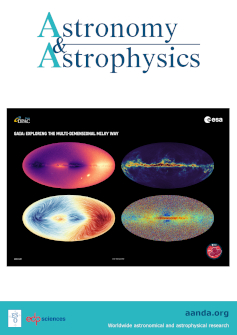帕克太阳探测器在金星重力辅助期间观测到的等离子体波调查
IF 5.4
2区 物理与天体物理
Q1 ASTRONOMY & ASTROPHYSICS
引用次数: 0
摘要
背景。帕克太阳探测器(PSP)执行金星重力辅助(VGAs),以降低其近日点。帕克太阳探测器在这些VGA期间进行高频电场和磁场观测,为研究金星诱导磁层中的等离子体波提供了机会。我们总结了这些 VGA 期间的等离子体环境,包括 PSP 穿越的近金星空间区域和关键的边界交叉。我们全面识别了这些VGA期间的朗缪尔波、离子声波、惠斯勒模式波和离子回旋波,并绘制了这些波在整个近金星空间的位置图。本研究分析了来自 PSP FIELDS 仪器套件的不同数据产品,这些数据来自前五次 VGA。我们将FIELDS仪器的能力与先锋金星轨道器(PVO)和金星快车(VEX)上的等离子体波仪器的能力进行了比较。我们发现,PVO电场仪器非常适合观测朗缪尔波,尤其是在弓形冲击附近和前冲击中。然而,对 PSP FIELDS 探测到的其他等离子体波的评估显示,PVO 和 VEX 通常无法观测到这些波模式的关键特征,包括最大功率、带宽和传播方向。这些波的特征提供了有关波的产生机制和波粒相互作用的关键信息,因此提供了有关金星诱导磁层性质的基本信息。这些结果突显了自 PVO 和 VEX 时代以来的几十年中等离子体波仪器能力的进步,并说明了等离子体波仪器在新的金星任务中的价值。本文章由计算机程序翻译,如有差异,请以英文原文为准。
Plasma wave survey from Parker Solar Probe observations during Venus gravity assists
Context. Parker Solar Probe (PSP) performs Venus gravity assists (VGAs) in order to lower its perihelion. PSP takes high-cadence electric and magnetic field observations during these VGAs, providing the opportunity to study plasma waves in Venus’s induced magnetosphere.Aims. We summarize the plasma environment during these VGAs, including the regions of near-Venus space that PSP traversed and the key boundary crossings. We comprehensively identify Langmuir, ion acoustic, whistler-mode, and ion cyclotron waves during these VGAs and map the location of these waves throughout near-Venus space.Methods. This study analyzes different data products from the PSP FIELDS instrument suite from throughout the first five VGAs.Results. We compare the FIELDS instrumentation capabilities to the capabilities of the plasma wave instruments on board the Pioneer Venus Orbiter (PVO) and the Venus Express (VEX). We find that the PVO electric field instrument was well suited to observe Langmuir waves, especially near the bow shock and in the foreshock. However, evaluation of the other plasma waves detected by PSP FIELDS reveals that PVO and VEX would have often been unable to observe key features of these waves modes, including maximum power, bandwidth, and propagation direction. These wave characteristics provide critical information on the wave generation mechanisms and wave-particle interactions, so provide fundamental information on the nature of Venus’s induced magnetosphere.Conclusions. These results highlight the advances in plasma wave instrumentation capabilities that have been made in the decades since the PVO and VEX eras, and illustrate the value of a plasma wave instrument on a new Venus mission.
求助全文
通过发布文献求助,成功后即可免费获取论文全文。
去求助
来源期刊

Astronomy & Astrophysics
地学天文-天文与天体物理
CiteScore
10.20
自引率
27.70%
发文量
2105
审稿时长
1-2 weeks
期刊介绍:
Astronomy & Astrophysics is an international Journal that publishes papers on all aspects of astronomy and astrophysics (theoretical, observational, and instrumental) independently of the techniques used to obtain the results.
 求助内容:
求助内容: 应助结果提醒方式:
应助结果提醒方式:


